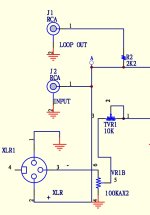As to the topic of V regs in the front end of power amps, I've been a bit fascinated by Allen Wright's research on shunt regs. While some of his ideology is a bit extreme for most practical applications, I do agree with his views on the benefits of a wide band, low noise circuit that can source and sink.
The problem I forsee with this is how to practically implement it without making it too over-engineered. The calculated load has to be right in the butter zone, half way between sourcing and sinking. Otherwise the effort won't be worth it when the load shifts due to temps and demand. That makes class A drive stages a must. When compared to the zener + series R circuit, there's not much difference aside from the series regulator responding with its active feedback loop. The reverse junction noise is the worst part on shunted zener reg, but the noise level depends on far how "on" it is.
Bootstrapping is another way to increase the current capacity. Some of the LT10×× regs can improve upon the typical 3 pin series regs using a boot strapped power transistor and series drop R. Getting the frequency bandwidth linear is the other struggle as with all the other reg topologies.
For now, the upgraded ballast resistors work acceptably until a more linear wideband solution is found.
The A21 is built to a budget and I believe they nailed it for the most part. I do believe the ballasted zener is the most cost effective solution but based on my own experience, upgrading this would greatly elevate the A21 to a substantially higher performance level.
The problem I forsee with this is how to practically implement it without making it too over-engineered. The calculated load has to be right in the butter zone, half way between sourcing and sinking. Otherwise the effort won't be worth it when the load shifts due to temps and demand. That makes class A drive stages a must. When compared to the zener + series R circuit, there's not much difference aside from the series regulator responding with its active feedback loop. The reverse junction noise is the worst part on shunted zener reg, but the noise level depends on far how "on" it is.
Bootstrapping is another way to increase the current capacity. Some of the LT10×× regs can improve upon the typical 3 pin series regs using a boot strapped power transistor and series drop R. Getting the frequency bandwidth linear is the other struggle as with all the other reg topologies.
For now, the upgraded ballast resistors work acceptably until a more linear wideband solution is found.
The A21 is built to a budget and I believe they nailed it for the most part. I do believe the ballasted zener is the most cost effective solution but based on my own experience, upgrading this would greatly elevate the A21 to a substantially higher performance level.
Thank you very much for your opinion!I think the A21 would do just fine with that load. I'd stay away from the first generation model A21 with the 80V main filter caps. These were eventually upgraded to the 100V caps because the rails were running right at 80V on the A21, so filter caps wouldn't last long run right at max voltage all the time. Otherwise they're very reliable.
I'll stay tuned! Hoping to be able to apply your solution, even if modifications to a commercial device always have the trade-off of making it lose market value, unfortunately I doubt that anyone will want to spend money, even if correctly valued, for a 'modified machine that is no longer original'.The A21 is built to a budget and I believe they nailed it for the most part. I do believe the ballasted zener is the most cost effective solution but based on my own experience, upgrading this would greatly elevate the A21 to a substantially higher performance level.
@andreaemme it depends on how the modifications are done and whether they can be substantiated. I've purchased modified gear and never was worried about market value after the fact. Usually you end up keeping the equipment which has the most potential. If the performance has been improved without any questionable reliability issues, the value is retained and often increases. I'm also a proponent of making mods reversible, which means there are no consequences to market value being able to remove them before sale.
Of course, I'd have no doubt to acquire a modded machine from you, but somebody may have many doubt to buy a modded machine from me, not expert, but reversibility may be the right way to operate, so I would be grateful if you'll share your results and the modded circuitry, so I can try applying it to mine.
Sorry to take advantage of this conversation, as far as you know, does the switch between balanced and unbalanced input isolate the unused branch from the other? In other words, can I always keep two different sources connected to the A21, one balanced and one unbalanced, and use the switch to listen to one or the other?
Sorry to take advantage of this conversation, as far as you know, does the switch between balanced and unbalanced input isolate the unused branch from the other? In other words, can I always keep two different sources connected to the A21, one balanced and one unbalanced, and use the switch to listen to one or the other?
@andreaemme The inputs aren't isolated from balanced to single ended. I prefer to install locking silver plated XLR to avoid any unintended disconnects and to improve connection quality. The input sensitivity controls are a potential weakness due to the resistive elements only being connected through pinch grommets. I upgrade these 2 areas on all of my A21s, then bias them to roughly 220W after about 30 min.
